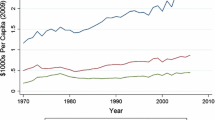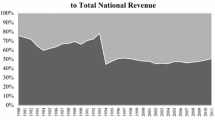Abstract
This article begins with a review of the now substantial literature on the thesis that polticians manipulate governmental outputs so as to favor their chances of reelection. It concludes that while this “electoral cycle” thesis was initially overstated by its proponents, it retains more plausibility than recent critics have allowed. This conclusion is then demonstrated through an analysis of expenditures by the ten provincial governments in Canada between 1951 and 1984.
Similar content being viewed by others
References
Alt, J.E. and Chrystal, K.A. (1983). Political economics. Berkeley: University of California Press.
Alesina, A. (1987). Macroeconomic policy in a two-party system as a repeated game. Journal of Economics 102: 651–678.
Alesina, A. (1988). Macroeconomics and politics. In S. Fischer (Ed.), NBER macroeconomics annual. Cambridge: MIT Press.
Alesina, A. (1989). Politics and business cycles in industrial democracies. Economic Policy 8: 54–87.
Alesina, A. and Sachs, J. (1988). Political parties and the business cycle in the United States, 1948–1984. Journal of Money, Credit and Banking 20: 62–82.
Alesina, A. and Roubini, N. (1990). Political cycles in OECD economies. Stockholm: Conference on Economic Policy in Political Equilibrium.
Anderson, T.W. and Hsiao, C. (1982). Formulation and estimation of dynamic models using panel data. Journal of Econometrics 18: 47–82.
Beck, N. (1987). Elections and the Fed: Is there a political monetary cycle? American Journal of Political Science 31: 194–216.
Betancourt, R. and Kelejan, H. (1981). Lagged endogenous variables and the Cochrane-Orcutt procedure. Econometrica 49: 1073–1078.
Bizer, D.S. and Durlouf, S.N. (1989). The behavior of U.S. tax rates: 1879–1986. Unpublished Manuscript, Stanford University.
Blais, A. (1982). Politique agricole et résultats électoraux en milieu agricole au Québec. Canadian Journal of Political Science 11: 333–383.
Blais, A., McRoberts, K. and Nadeau, R. (1983). Les cycles électoraux et les dépenses des gouvernements du Québec et de l'Ontario. Vancouver, Congrès annuel de l'Association Canadienne de Science Politique.
Borjas, G.J. (1984). Electoral cycles and the earnings of federal bureaucrats. Economic Inquiry 22: 447–460.
Brown, T.A. and Stein, A.A. (1982). The political economy of national elections. Comparative politics 14: 479–499.
Cain, B., Ferejohn, J. and Fiorina, M. (1987). The personal vote: constituency service and electoral independence. Cambridge: Harvard University Press.
Cameron, D.R. (1978). The expansion of the public economy: A comparative analysis. American Political Science Review 72: 1234–1261.
Cameron, D.R. (1986). The growth of government spending: The Canadian experience in comparative perspective. In K. Banting (Ed.), State and society: Canada in comparative perspective. Toronto: University of Toronto Press.
Cusak, T.R., Notermans, T. and Rein, M. (1989). Politico-economic aspects of public employment. European Journal of Political Research 17: 471–500.
Doron, G. and Tamir, B. (1983). The electoral cycle: A political economic perspective. Crossroads, pp. 141–164.
Dupré, R. (1987). The evolution of Quebec government expenditures, 1867–1969. Ph.D. Dissertation, University of Toronto.
Durbin, J. (1970). Testing for serial correlation in least-squares regression when some of the regressors are lagged dependent variables. Econometrica 38: 410–421.
Foot, D.K. (1977). Provincial public finance in Ontario: An empirical analysis of the last twenty-five years. Toronto: Ontario Economic Council.
Foot, D.K. (1979). Political cycles, economic cycles and the trend of public employment in Canada. In M.W. Bucovetsky (Ed.), Studies in public employment and compensation in Canada. Montreal: Institute for Policy Research.
Frey, B.S. (1978). Politico-economic models and cycles. Journal of Public Economics 9: 203–220.
Frey, B.S. and Schneider, F. (1978a). An empirical study of politico-economic interaction in the United States. Review of Economics and Statistics 60: 174–184.
Frey, B.S. and Schneider, F. (1978). A politico-economic model of the United Kingdom. Economic Journal 88: 243–254.
Frey, B.S. and Schneider, F. (1979). An econometric model with an endogenous government sector. Public choice 34: 25–45.
Golden, D.G. and Poterba, J.M. (1980). The price of popularity: The political business cycle reexamined. American Journal of Political Science 24: 696–714.
Gow, J.I. (1985). Histoire de l'administration québécoise, 1867–1970. Montreal: Presses de l'Université de Montréal.
Grier, K.B. (1989). On the existence of a political monetary cycle. American Journal of Political Science 33: 376–390.
Hamelin, J. and Caron, A. (1969). La vie politique au Québec. In V. Lemieux (Ed.), Quatre elections provinciales au Québec. Québec: Presses de l'Université Laval.
Haynes, S.E. and Stone, J.A. (1990). Political models of the business cycle should be revised. Economic Inquiry 28: 442–465.
Hibbs, D.A. (1977). Political parties and macroeconomic outcomes. American Political Science Review 71: 1467–1487.
Hibbs, D.A. (1987). The American political economy: Macroeconomics and electoral politics in the United States. Cambridge: Harvard University Press.
Hsiao, C. (1986). Analysis of panel data. Cambridge: Cambridge University Press.
Kavanagh, D. (1989). The timing of elections: The British case. In I. Crewe and M. Harrop (Eds.), Political communications: The general election campaign of 1987. Cambridge: Cambridge University Press.
Kiewiet, D.R. and McCublins, M.D. (1985). Congressional appropriations and the electoral connection. Journal of politics 47: 59–83.
Kmenta, J. (1971). Elements of econometrics. New York: Macmillan.
Lowery, D. (1985). The Keynesian and political determinants of unbalanced budgets: U.S. fiscal policy from Eisenhower to Reagan. American Journal of Political Science 29: 429–460.
Maddala, G.S. (1977). Econometrics. New York: McGraw-Hill.
Maslove, A.M., Prince, M.J. and Doern, G.B. (1985). Federal and provincial budgeting. Toronto: University of Toronto Press.
Mintz, A. (1988). Electoral cycles and defense spending: A comparison of Israel and the United States. Comparative Political Studies 21: 368–381.
Monière, D. (1988). Le discours électoral: Les politiciens sont-ils fiables? Montréal: Québec Amérique.
Nickell, S. (1981). Biases in dynamic models with fixed effects. Econometrica 49: 1399–1416.
Paldam, M. (1979). Is there an electoral cycle? A comparative study of national accounts. Scandinavian Journal of Economics 81: 323–342.
Paldam, M. (1981). An essay on the rationality of economic policy: The test case of an electoral cycle. Public Choice 37: 287–307.
Paldam, M. (1989). Does politic matter at all?: A comparative test of partisan cycles for 17 countries. Unpublished Manuscript, Aarhus University.
Rogoff, K. (1987). Equilibrium political budget cycles. NBER Working Paper No. 2428.
Rogoff, K. (1990). Equilibrium political budget cycles. American Economic Review 80: 21–36.
Rogoff, K. and Siebert, A. (1988). Elections and macroeconomic policy cycles. Review of Economic Studies 55: 1–16.
Saywell, J. (1962). Parliament and politics. In J. Saywell (Ed.), Canadian Annual Review for 1962. Toronto: University of Toronto Press.
Simeon, R. and Miller, R.E. (1980). Regional variations in public policy. In D. Elkins and R. Simeon (Eds.), Small worlds: Provinces and parties in Canadian political life, 242–284. Toronto: Methuen.
Sorensen, R.J. (1987). Macroeconomic policy and government popularity in Norway, 1963–1986. Scandinavian Political Studies 10: 301–322.
Spafford, D. (1981). Highway employment and provincial elections. Canadian Journal of Political Science 14: 135–143.
Stimson, J.A. (1985). Regression in space and time: A statistical essay. American Journal of Political Science 29: 914–947.
Thomas, M. (1985). Election proximity and senatorial roll call voting. American Journal of Political Science 29: 96–112.
Tufte, E.R. (1978). Political control of the economy. Princeton: Princeton University Press.
Author information
Authors and Affiliations
Rights and permissions
About this article
Cite this article
Blais, A., Nadeau, R. The electoral budget cycle. Public Choice 74, 389–403 (1992). https://doi.org/10.1007/BF00137686
Accepted:
Issue Date:
DOI: https://doi.org/10.1007/BF00137686




